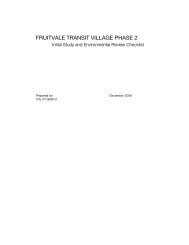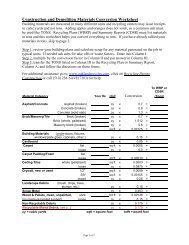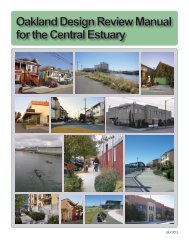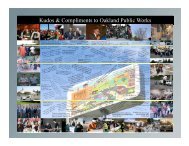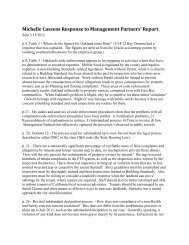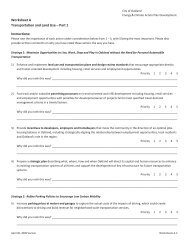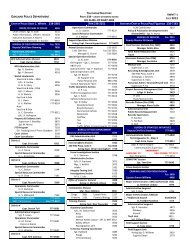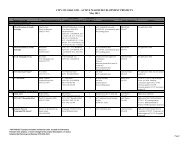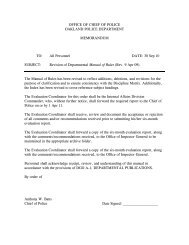Intelligent Transportation Systems - City of Oakland
Intelligent Transportation Systems - City of Oakland
Intelligent Transportation Systems - City of Oakland
You also want an ePaper? Increase the reach of your titles
YUMPU automatically turns print PDFs into web optimized ePapers that Google loves.
• LED Hybrid – LED hybrid signs join the technologies <strong>of</strong> LED with conventional flipdisk<br />
signs. Each reflective disk has a small hole in the center. When the colored<br />
side <strong>of</strong> the disk is displayed, it opens up the pixel <strong>of</strong> the LED which provides internal<br />
illumination <strong>of</strong> the message. LED hybrid signs are typically more visible than<br />
conventional flip-disk signs and <strong>of</strong>fer good day and night visibility. Flip disks are<br />
prone to occasional sticking.<br />
• Fiber Optic – Fiber optic signs use a cluster <strong>of</strong> light emitting fibers attached to a light<br />
guide. The fibers from one or more light guides are used to make a pixel that is<br />
illuminated by a halogen lamp. The light guide passes the light from the lamp to all<br />
its fibers. To make a particular character, selected lamps or small rotating shutters<br />
are energized to create the character pattern. Brightness <strong>of</strong> pixels may be partially<br />
controlled by adjusting the number <strong>of</strong> fibers per pixel. A standby lamp is used when<br />
extra brightness is needed and as backup to the halogen lamps. The text or<br />
graphics are displayed in pure white light. Colored displays are obtained by sending<br />
the white light through colored filters to achieve the desired color.<br />
• Fiber Optic Hybrid – A fiber optic hybrid sign joins the technologies <strong>of</strong> optical fiber<br />
display with conventional flip-disk signs. Each reflective disk has a small hole in the<br />
center. When the colored side <strong>of</strong> the disk is displayed, it opens up the pixel <strong>of</strong> the<br />
illuminated fiber which provides illumination <strong>of</strong> the message. Fiber optic hybrid signs<br />
are typically more visible than conventional flip-disk signs and <strong>of</strong>fer good day and<br />
night visibility. Flip disks are prone to occasional sticking.<br />
DMS Recommendations - Based on the currently available technologies, LED Hybrid is<br />
recommended as the preferred option for DMS displays in the <strong>City</strong> <strong>of</strong> <strong>Oakland</strong> since it<br />
combines the attributes <strong>of</strong> LED and reflective flip-disk displays to <strong>of</strong>fer good day and<br />
night visibility. DMS should be located on major routes near heavily traveled areas such<br />
as the Airport, Coliseum, Convention Center and Jack London Square in advance <strong>of</strong><br />
major decision points. Signs should be placed such that the motorist can read the<br />
message, make a decision, and perform the required traffic movements safely.<br />
4.2.4 Trailblazer Signs (TBS)<br />
TBS are essentially limited-message capability DMS. They<br />
provide immediate information to a high volume <strong>of</strong> traffic at<br />
major decision points, enabling drivers to make quick route<br />
selections. TBS are generally deployed in urban areas at<br />
freeway ramps and on parallel surface routes, and on smart<br />
corridors to suggest alternate surface routes for motorists to<br />
use during an incident. TBS are typically left blank, and when<br />
the need arises, a message indicating the alternate freeway or<br />
roadway, along with text and an arrow signifying the direction<br />
<strong>of</strong> traffic on the freeway, are displayed.<br />
The <strong>City</strong> <strong>of</strong> <strong>Oakland</strong> and the <strong>Oakland</strong> Fire Department<br />
expressed the desire for TBS in the immediate areas<br />
surrounding the <strong>Oakland</strong> Airport and the <strong>Oakland</strong> Coliseum<br />
and along predetermined evacuation routes throughout the<br />
<strong>City</strong>. The TBS could quickly reroute traffic after special<br />
<strong>City</strong> <strong>of</strong> <strong>Oakland</strong> ITS Strategic Plan<br />
41 September, 2003





